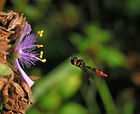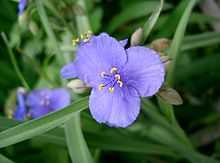Tradescantia
| Tradescantia | |
|---|---|
 | |
| Tradescantia virginiana | |
| Scientific classification | |
| Kingdom: | Plantae |
| (unranked): | Angiosperms |
| (unranked): | Monocots |
| (unranked): | Commelinids |
| Order: | Commelinales |
| Family: | Commelinaceae |
| Subfamily: | Commelinoideae |
| Tribe: | Tradescantieae |
| Subtribe: | Tradescantiinae |
| Genus: | Tradescantia L., 1753[1] |
| Species | |
|
About 70, including: | |
| Synonyms | |
|
Campelia Rich. | |
Tradescantia /ˌtrædɨˈskæntiə/,[2] the Spiderworts, is a genus of an estimated 71 species of perennial plants in the family Commelinaceae, native to the New World from southern Canada south to northern Argentina. They are weakly upright to scrambling plants, growing to 30–60 cm tall, and are commonly found individually or in clumps in wooded areas and fields. The leaves are long, thin and bladelike to lanceolate, from 3–45 cm long. The flowers can be white, pink, or purple, but are most commonly bright blue, with three petals and six yellow anthers. The sap is mucilaginous and clear. A number of the species flower in the morning and when the sun shines on the flowers in the afternoon they close, but can remain open on cloudy days until evening. Unlike most wildflowers of the United States and Canada (other than orchids and lilies), spiderworts are monocots and not dicots.
Though sometimes considered a weed, spiderwort is cultivated for borders and also used in containers. Where it appears as a volunteer, it is often welcomed and allowed to stay.
The first species described, Virginia Spiderwort T. virginiana, is native to the eastern United States from Maine to Alabama, and Canada in southern Ontario. Virginia Spiderwort was introduced to Europe in 1629, where it is cultivated as a garden flower.
Some members of the genus Tradescantia may cause allergic reactions in pets (especially cats and dogs), characterised by red, itchy skin. Notable culprits include T. albiflora (Scurvy Weed); T. spathacea (Moses In The Cradle); and T. pallida (Purple Heart).
The Western Spiderwort T. occidentalis is listed as an endangered species in Canada, where the northernmost populations of the species are found at a few sites in southern Saskatchewan, Manitoba and Alberta; it is however more common further south in the United States south to Texas and Arizona.
The three species of Wandering Jew, one native to eastern Mexico, also belong to the Tradescantia genus. Other names used for various species include Spider-lily, Cradle-lily, Oyster-plant and Flowering Inch Plant.
The name of the genus honours the English naturalists John Tradescant the Elder (ca. 1570s – 1638) and John Tradescant the Younger (1608–1662).[3]

Stamen hairs and ionizing radiation
The cells of the stamen hairs of some Tradescantia are colored blue, but when exposed to sources of ionizing radiation such as gamma rays, the cells mutate and change color to pink; they are one of the few tissues known to serve as an effective bioassay for ambient radiation levels.[4]
Selected species
David Hunt divided the genus into 11 sections, with the nominate section broken down into a further four series.[5][6]
|
|
Formerly placed here
- Callisia navicularis (Ortgies) D.R.Hunt (as T. navicularis Ortgies)
- Callisia warszewicziana (Kunth & C.D.Bouché) D.R.Hunt (as T. warszewicziana Kunth & C.D.Bouché)
- Gibasis geniculata (Jacq.) Rohweder (as T. geniculata Jacq.)
- Gibasis karwinskyana (Schult. & Schult.f.) Rohweder (as T. karwinskyana Schult. & Schult.f.)
- Gibasis pellucida (M.Martens & Galeotti) D.R.Hunt (as T. pellucida M.Martens & Galeotti)
- Siderasis fuscata (Lodd. et al.) H.E.Moore (as T. fuscata Lodd. et al.)
- Tinantia anomala (Torr.) C.B.Clarke (as T. anomala Torr.)
- Tripogandra diuretica (Mart.) Handlos (as T. diuretica Mart.)[8]
Gallery
-

Front view of leaves of Tradescantia pallida cv. "Purple Heart".
-

Back view of leaves of Tradescantia pallida cv. "Purple Heart".
-

Front view of leaves of Tradescantia zebrina cv. "Tricolor".
-

Back view of leaves of Tradescantia zebrina cv. "Tricolor".
-
Tradescantia ohiensis Ohio Spiderwort
-

Tradescantia ohiensis flowers
-

A budding Tradescantia flower
-

Tradescantia cv. "Red Grape".
References
- ↑ 1.0 1.1 "Genus: Tradescantia L.". Germplasm Resources Information Network. United States Department of Agriculture. 2004-08-10. Retrieved 2011-03-20.
- ↑ Sunset Western Garden Book, 1995:606–607
- ↑ Quattrocchi, Umberto (2000). CRC World Dictionary of Plant Names: Common Names, Scientific Names, Eponyms, Synonyms, and Etymology. IV R-Z. Taylor & Francis US. p. 2697. ISBN 978-0-8493-2678-3.
- ↑ Ichikawa, Sadao (1972). "Somatic Mutatiion Rate in Tradescantia Stamen Hairs at Low Radiation Levels: Finding of Low Doubling Doses of Mutations". The Japanese Journal of Genetics 47 (6): 411–421. doi:10.1266/jjg.47.411.
- ↑ 5.0 5.1 Hunt, David R. (1980). "Sections and Series in Tradescantia: American Commelinaceae: IX". Kew Bulletin 35 (2): 437–442. JSTOR 4114596.
- ↑ 6.0 6.1 Hunt, David R. (1986). "Campelia, Rhoeo and Zebrina united with Tradescantia: American Commelinaceae: XIII". Kew Bulletin 41 (2): 401–405. JSTOR 4102948.
- ↑ "Tradescantia". Integrated Taxonomic Information System. Retrieved 2011-06-16.
- ↑ 8.0 8.1 "GRIN Species Records of Tradescantia". Germplasm Resources Information Network. United States Department of Agriculture. Retrieved 2011-06-16.
External links
| Wikimedia Commons has media related to Tradescantia. |
| Wikispecies has information related to: Tradescantia |
| Wikisource has the text of the 1920 Encyclopedia Americana article Spiderwort. |
- Flora of North America: Tradescantia (includes species in USA and Canada only)
- PlantSystematics: Tradescantia
- Western Spiderwort endangered in Canada
